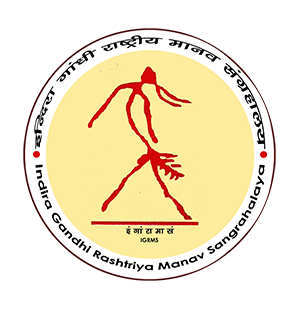संथाल
जिलाः दुमका
राज्यः झारखण्ड
संकलन वर्ष: 1988
संथाल भारत का तीसरा बड़ा जनजातीय समुदाय है ये बिहार, झारखण्ड, पश्चिम बंगाल, उडीसा तथा त्रिपुरा राज्यों में विस्तारित हैं। ये प्रमुखतः राजमहल, दुमका, सिंहभूम, संथाल, परगना, दीगा, हजारीबाग, धनबाद तथा बिहार के पूर्णिया जिले में है। इनका प्रमुख व्यवसाय कृषि है लेकिन आखेट एवं संग्रहण भी संथालि लोगों की पारम्परिक गतिविधि रही है।
संथाल गांव के एक तरु के साथ घरों ओर घुमावदार गलिया होते हैं। आवासों को कई तरिकों से निर्मित किया जाता है। दीवारों का निर्माण पतले खम्भों पर बांस की खपच्चियों को बांधकर उन पर गोबर एवं मिट्टी की लिपाई कर किया और अंत में सफेद मिट्टी से समका कर किया जाता है। दोहरे ढलान वाली छत साल की लकड़ी पर जंगली घास या धान की पुआल के छाजन से बनाई जाती है। प्रत्येक आवास के अंदर एक छोटी दीवार होती है जो मकान को पूर्वजों की पूजा हेतु एक छोटे कक्ष में विभाजित करती है। मकान के सामने एक बरामदा होता है। घर का फर्श जमीन से थोड़ा उपर उठा हुआ बनाया जाता है। घरों के अंदर घांस को पुआल के रूप में रखा जाता है। चूल्हा मिट्टी का बनाया जाता है जो दो या अधिक तरफ से खुला रहता है। ये ढेकी को घर के दायी ओर रखते हैं। मवेशियों को प्रथक शेड में रखा जाता है। सुअरों का बाड़ा स्थित होता है जिसका द्वार गांव की गली को जाता है। प्रत्येक घर में दो कक्ष होते है भीतरी ओरा, सोने और सब्जियाँ रखने के लिये होता है। वे कभी भी बाहरी लोगों को भीतरी कक्षों में प्रवेश की अनुमति नहीं देते। संथालों की एक समृद्ध कला परम्परा है। वे अपने घर की दीवारों को सजाने के लिये पक्षियों, फूलों, पशुओं, वक्षों तथा शिकार और नृत्यरत मनुष्यों की मुद्रांए बनाते है। इन चित्रों में काले, लाल और सफेद प्राकृतिक रंगों का इस्तेमाल करते है। बाहरी कक्ष ”धाबा” मेहमान एवं रसोई के लिए उपयोग किया जाता है।
Santhal
Dist.: Dumka
State: Jharkhand
Year of collection: 1988
Santal is the third largest tribal community of India. They are distributed in the states of Bihar, Jharkhand, West Bengal, Orrissa and Tripura. Santal call themselves ‘Hor means man. Their highest concentration is found in Rajmahal, Dumka, Singbhum Digha districts of Santal Pargana and Hazari Bag, Dhanbad and Purnea districts of Bihar. Their main occupation is settled agriculture but hunting, gathering are also traditional practiced by the Santal people.
The Santal village consists of a straggling street with houses on either side. The houses are built in several ways. Walls are made by fixing thin poles, tying them with cross saplings twigs, finishing with a plaster of clay and cow-dung and lastly glazing with white clay. The roof is two sloped and made with rafter of Salwood, thatched with jungle grass. Inside every dwilling there is a low wall used to divide the house into small compartment named Bhitar where the ancestors are worshiped. In front of the house there is a verandah. The floor of the house is raised above the ground. Inside the house they keep the paddy in straw bundles. The fireplace is made of clay having two or more openings. They put their Dheki to the right side of the house. Cattle are kept in a separate cattle shed. Pig sty is situated at one side and it has one door to the village street. In every house there are two rooms one called Bhitriora is used for sleeping purpose and keeping vegetables. The outer room is called Dhaba which is used for guests and also as a kitchen. They never allow the outsiders to enter the inner room. Santal, have a rich artistic tradition. They create figures of birds, flowers, animals, tree and forms of human beings in hunting and dancing postures to decorate the walls of their dwellings. They use black, red and white natural colours for these paintings.



